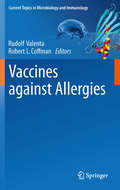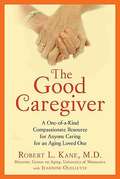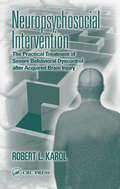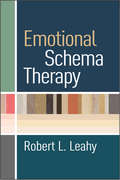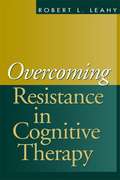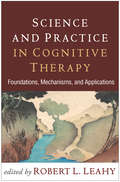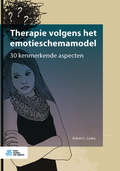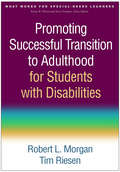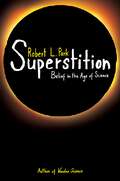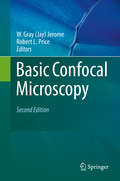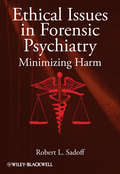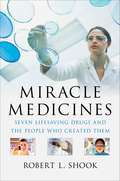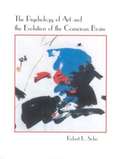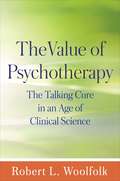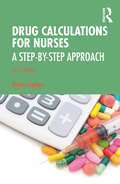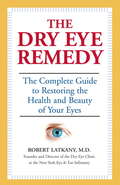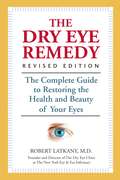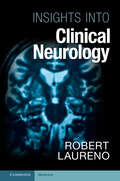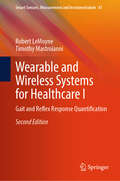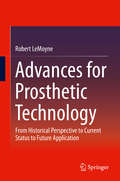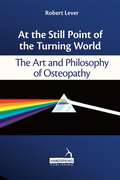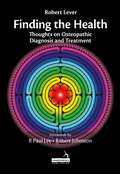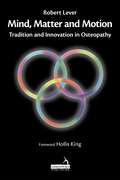- Table View
- List View
Clinical Pharmacology and Therapeutics for Veterinary Technicians (Fourth Edition)
by Robert L. BillGrasp complex concepts and develop fundamental knowledge in the rapidly changing field of veterinary pharmacology with Clinical Pharmacology and Therapeutics for Veterinary Technicians, 4th Edition. This accessible, comprehensive text explains how drugs work so you can confidently communicate with clients about current drug therapies. Featuring up-to-date drug information and a new full-color design with added illustrations, tables, and boxes, this thorough resource covers drug uses, abuses, calculation errors, and mistakes.
Vaccines against Allergies
by Rudolf Valenta Robert L. CoffmanWe are celebrating this year the hundred years´ anniversary of allergen-specific immunotherapy. In 1911 Leonard Noon published his seminal work "Prophylactic inoculation against hay fever" describing his attempts to achieve active immunity against "grass pollen toxin" by administering increasing doses of grass pollen extract before the grass pollen season to allergic patients. Although it was unknown at that time that allergy represents an immunological hypersensitivity disease, the treatment was effective and many observations made by Noon remained valid until today. Today allergen-specific immunotherapy is well established as the only allergen-specific and disease-modifying treatment for IgE-mediated allergies and has long-lasting effects. In fact, more than 25% of the population suffer from IgE-mediated allergies which therefore represent a major health burden of our society, particularly because untreated allergy often progresses to severe disabling forms of disease, such as asthma and sometimes kills sensitized people through anaphylaxis.
The Good Caregiver
by Robert L. Kane Dr.A survival guide with an insider's perspective, for the millions of unprepared caregivers of aging loved ones. As Americans are living longer, an unprecedented number of people now require long-term care during their last years. More than 15 million adult children now care for their elderly parents, and unsuspecting caregivers are usually unprepared financially, emotionally, and practically for the relentless job they will face. In The Good Caregiver, world-renowned expert on aging and long- term care Dr.Robert Kane provides a road map for caregiving. More than just a professional expert, Dr. Kane draws on his personal experience of caring for his aging mother after she struggled from a debilitating stroke. Dr. Kane offers heartfelt advice for those learning how to best care for their loved one and how to make thoughtful, informed decisions at each stage of the caring process: ? How does a nursing home differ from assisted living? ? How is a homemaker different from a home health aide? ? How far can you trust a hospital discharge planner? ? What services does Medicare cover, and much, much more The Good Caregiver equips readers to deal more effectively with the challenges of day-to-day care and to navigate the system itself, including legal, financial, and interpersonal hurdles. Filled with stories and sidebars from other caregivers, The Good Caregiver offers a candid, personal approach to caregiving, providing fearless answers to difficult scenarios with humor and encouragement.
Neuropsychosocial Intervention: The Practical Treatment of Severe Behavioral Dyscontrol After Acquired Brain Injury
by Robert L. KarolNeuropsychosocial intervention is an innovative and clinically proven treatment approach to severe behavioral problems that can affect persons with acquired brain injury. This book outlines the nature and significance of behavioral dyscontrol, explains aggression, and details the neuropsychosocial treatment approach and the principles on which it i
Am I My Genes?: Confronting Fate And Family Secrets In The Age Of Genetic Testing
by Robert L. KlitzmanIn the fifty years since DNA was discovered, we have seen extraordinary advances. For example, genetic testing has rapidly improved the diagnosis and treatment of diseases such as Huntington's, cystic fibrosis, breast cancer, and Alzheimer's. But with this new knowledge comes difficult decisions for countless people, who wrestle with fear about whether to get tested, and if so, what to do with the results. <p><p> Am I My Genes? shows how real individuals have confronted these issues in their daily lives. Robert L. Klitzman interviewed 64 people who faced Huntington's Disease, breast and ovarian cancer, or Alpha-1 antitrypsin deficiency. The book describes--often in the person's own words--how each has wrestled with the vast implications that genetics has for their lives and their families. Klitzman shows how these men and women struggle to make sense of their predicament and its causes. They confront a series of quandaries--whether to be tested; whether to disclose their genetic risks to parents, siblings, spouses, offspring, friends, doctors, insurers, employers, and schools; how to view and understand themselves and their genetics; what treatments, if any, to pursue; whether to have children, adopt, screen embryos, or abort; and whether to participate in genetic communities. In the face of these uncertainties, they have tried to understand these tests and probabilities, avoid fatalism, anxiety, despair, and discrimination, and find hope, meaning, and a sense of wholeness. Forced to wander through a wilderness of shifting sands, they chart paths that many others may eventually follow. <p> Klitzman captures here the voices of pioneers, some of the first to encounter the personal dilemmas introduced by modern genetics. Am I My Genes? is an invaluable account of their experience, one that will become all the more common in the coming years.
Emotional Schema Therapy
by Robert L. LeahyOver decades of practice of cognitive-behavioral therapy (CBT), Robert L. Leahy has made important discoveries about the role that beliefs and expectations about emotions play in psychopathology. This book presents innovative tools for helping patients to understand their emotional schemas--such as the conviction that painful feelings are unbearable, shameful, or will last indefinitely--and develop new ways of accepting and coping with affective experience. Therapists can integrate emotional schema therapy into the treatment approaches they already use to add a vital new dimension to their work. Rich case material illustrates applications for a wide range of clinical problems; assessment guidelines and sample worksheets and forms further enhance the book's utility.
Overcoming Resistance in Cognitive Therapy
by Robert L. LeahyDespite the efforts of therapists and patients, many patients in cognitive-behavioral therapy or any therapy do not improve. This unique book is designed to help the clinician better understand and work with patients who seem unable or unwilling to make needed changes. Integrating ideas from a range of psychotherapeutic approaches, the book presents a multidimensional model of resistance. It enumerates the specific impediments to change that may arise in the cognitive therapy context and brings each one to life with realistic clinical illustrations. Clinicians learn practical strategies and interventions to deal with a number of types of resistance, from reluctance to comply with basic cognitive procedures to risk-aversion and self-handicapping. Also addressed are countertransference issues, including workable ways that clinicians can modify their own responses to patients to overcome impasses in treatment.
Science and Practice in Cognitive Therapy: Foundations, Mechanisms, and Applications
by Robert L. LeahyFrom leading experts in cognitive-behavioral therapy (CBT)--including CBT originator Aaron T. Beck and many who have worked closely with him--this book provides an overview of where the field is today and presents cutting-edge research and clinical applications. Contributors explain how Beck's cognitive model has been refined and tested over the last 45 years and describe innovative CBT approaches that integrate mindfulness, imagery, emotion-focused interventions, and other strategies. Chapters on specific clinical problems cover the conceptualization and treatment of depression, anxiety disorders, posttraumatic stress disorder, obsessive–compulsive disorder, insomnia, suicidality, substance abuse, couple and family problems, bipolar disorder, psychosis, and personality disorders.
Therapie volgens het emotieschemamodel: 30 kenmerkende aspecten
by Robert L. LeahyDit boek helpt zorgprofessionals bij de behandeling van cliënten met complexe emoties. Met het beschreven emotieschemamodel krijgen cliënten inzicht in hun emotieschema’s en leren ze ermee om te gaan. Het boek is bedoeld voor psychotherapeuten, psychiaters, psychologen en andere hulpverleners die zich willen verdiepen in emoties en emotieregulatie. Therapie volgens het emotieschemamodel: 30 kenmerkende aspecten beschrijft een nieuw model en biedt nieuwe inzichten over de manier waarop we denken over emoties, hoe we emoties waarderen en hoe we ermee omgaan. Hiervoor combineert de auteur zijn praktijkervaring met theorieën over cognitie, metacognitie en compassie. U leest hoe cliënten manieren kunnen ontwikkelen om met hun emoties om te gaan en deze te accepteren. Daarbij wordt onder andere ingegaan op emotieregulatiestrategieën, persoonlijk empowerment en interpersoonlijke emotieschema’s. De theorie in het boek wordt verduidelijkt met voorbeelden uit de praktijk. De instrumenten die aangereikt worden, zijn direct te gebruiken binnen bestaande behandelingen. Het boek is bondig geschreven en in compacte vorm uitgegeven. Hierdoor is het ideaal om als naslagwerk te gebruiken. Dr. Robert L. Leahy is onderzoeker en heeft jarenlange klinische ervaring. Hij is directeur van het American Institute for Cognitive Therapy in New York en is als Clinical Professor of Psychology, verbonden aan het Department of Psychiatry van Weill Cornell Medical College.
Promoting Successful Transition to Adulthood for Students with Disabilities (What Works for Special-Needs Learners)
by Tim Riesen Robert L. MorganComprehensively addressing the challenges of transition, this book provides practical knowledge and tools geared toward real-world educators. It presents clear guidelines for all aspects of team-based transition planning for individuals with various levels of disability, illustrated with vignettes of three secondary students who are followed throughout the book. The authors describe evidence-based practices for conducting assessments and promoting optimal outcomes in the areas of employment, postsecondary education, and independent living. Keys to family involvement, self-determination, interagency collaboration, and problem solving are highlighted. Several reproducible forms can be downloaded and printed in a convenient 8 1/2" x 11" size.
Superstition: Belief in the Age of Science
by Robert L. ParkWhy the battle between superstition and science is far from overFrom uttering a prayer before boarding a plane, to exploring past lives through hypnosis, has superstition become pervasive in contemporary culture? Robert Park, the best-selling author of Voodoo Science, argues that it has. In Superstition, Park asks why people persist in superstitious convictions long after science has shown them to be ill-founded. He takes on supernatural beliefs from religion and the afterlife to New Age spiritualism and faith-based medical claims. He examines recent controversies and concludes that science is the only way we have of understanding the world.Park sides with the forces of reason in a world of continuing and, he fears, increasing superstition. Chapter by chapter, he explains how people too easily mistake pseudoscience for science. He discusses parapsychology, homeopathy, and acupuncture; he questions the existence of souls, the foundations of intelligent design, and the power of prayer; he asks for evidence of reincarnation and astral projections; and he challenges the idea of heaven. Throughout, he demonstrates how people's blind faith, and their confidence in suspect phenomena and remedies, are manipulated for political ends. Park shows that science prevails when people stop fooling themselves.Compelling and precise, Superstition takes no hostages in its quest to provoke. In shedding light on some very sensitive--and Park would say scientifically dubious--issues, the book is sure to spark discussion and controversy.
Basic Confocal Microscopy
by Robert L. Price W. Gray JeromeBasic Confocal Microscopy, Second Edition builds on the successful first edition by keeping the same format and reflecting relevant changes and recent developments in this still-burgeoning field. This format is based on the Confocal Microscopy Workshop that has been taught by several of the authors for nearly 20 years and remains a popular workshop for gaining basic skills in confocal microscopy. While much of the information concerning fluorescence and confocal microscopy that made the first edition a success has not changed in the six years since the book was first published, confocal imaging is an evolving field and recent advances in detector technology, operating software, tissue preparation and clearing, image analysis, and more have been updated to reflect this. Several of these advances are now considered routine in many laboratories, and others such as super resolution techniques built on confocal technology are becoming widely available.
Ethical Issues in Forensic Psychiatry
by Robert L. SadoffEthical medical practice and treatment in psychiatry are based on the concept of first do no harm. However, this cannot, and does not, apply to forensic cases where there is no doctor-patient relationship and the forensic psychiatrist may indeed cause harm to the examinee. In this book, Robert Sadoff analyzes the ethical issues affecting forensic psychiatric practice, especially those promulgated by the American Academy of Psychiatry and the Law. Within those guidelines, he looks at individual bias, vulnerability of the examinee, and potential harm to the mental health professional. The book discusses each of the procedures of the forensic expert separately with respect to minimizing harm. It has been written with an international audience in mind and features chapters reviewing the European and UK perspectives, by Emanuele Valenti and John Baird, respectively.Robert Sadoff addresses the long-term harm that can be either avoided or minimized through careful planning and application of ethical principles. He is not advocating that the harm can be totally eliminated, because that is impossible in the adversarial system in which forensic psychiatrists work. However, there are means by which harm may be minimized if care is taken during the assessment, the report writing, and the testimony phase of the proceedings. The book develops the scope of forensic psychiatry from the standpoint of administrative, civil and criminal cases. It presents the practical issues involved in conducting forensic psychiatric assessments under various conditions plus special considerations, such as bias, minimizing harm, developing a therapeutic approach, and elaborating on various vulnerable individuals who are frequently examined in forensic cases. These include juveniles, mentally retarded, autistic, sexual assault victims, the elderly, the organically damaged, the psychotic, and mentally disabled prisoners. Immigrants are covered in a chapter by Solange Margery Bertoglia. The ethical issues in conducting forensic psychiatric examinations and presenting psychiatric testimony in court are examined and discussed. Cases illustrating the difficulties involved punctuate the presentation. The book closes with a fascinating account of the legal perspective by Donna Vanderpool.In summary, this book illustrates the ethical and practical issues that affect forensic psychiatric practice. The question is not what we do, but how we do it, and which standards, ethical guidelines and personal values contribute to the total picture. Despite the fact that we cannot always adhere to the doctrine of "primum non nocere," we can minimize the harm caused inherently by the adversarial system in which we participate.Praise for Ethical Issues in Forensic Psychiatry"One of the founding giants of the forensic psychiatric field has written here far more than a "mere" ethics textbook. Instead, this compendium serves multiple purposes: it is a valuable primer on forensic techniques of examination and testimony, a model of best forensic practices, and an instruction on the most appropriately civilized way in which to conduct oneself as a forensic psychiatrist.The success of these multiple accomplishments clearly derives from characteristics of the author. In both sage advice to practitioners and in many revealing case examples, Dr. Sadoff displays the tact, good manners and sensitivity of a consummate gentleman - a term not always associated with the hurly-burly of courtroom work. The book's primary focus on avoiding harm to all the parties involved in the work places it on the moral high ground of the legal system in which participating clinicians must find a place."Thomas G. Gutheil, MD, Professor of Psychiatry and Co-Founder, Program in Psychiatry and the Law, Beth Israel Deaconess Medical Center, Harvard Medical School
Miracle Medicines
by Robert L. ShookIt's the business of saving lives. Miracle Medicines goes behind the scenes of the pharmaceutical industry and into the high-security laboratories to tell the stories of the men and women---chemists, physiologists, medical and clinical researchers, engineers---who have chosen to toil for years in the lab in order to transform scientific theories into new lifesaving medicines. You'll witness the day-to-day labors, victories and defeats of the dedicated professionals who are waging a war against the diseases that still plague mankind. From the confines of their laboratories, these pharmaceutical adventurers explore unknown territories in health and science. Miracle Medicines reveals what really happens during the long and uncertain journey that each new drug and its creators must endure from theory, to research, to testing and, finally, FDA approval and delivery to the public. It's a very human story within the context of fascinating scientific innovation. Through first hand interviews you'll also meet the patients who benefit from these manmade miracles and learn how, within their bloodstreams, an ongoing battle is raging. The drugs profiled are: Advair: GlaxoSmithKline's revolutionary asthma medication, the first packaged as both a control and emergency drug. Gleevec: The Novartis' chronic myeloid leukemia treatment born from decades of medical research in a field of study that was once considered hopeless. Humalog: Eli Lilly's reinvention of insulin to control diabetes has been described as being better than nature Lipitor: Pfizer's miracle antidote for high cholesterol that was nearly lost to the pharmaceutical vaults and has since become the world's top-selling medicine. Norvir: Abbott's contribution to the fight against HIV that nearly erases all traces of the disease from the bloodstream and prolongs the life of patients. Remicade: Created for the treatment of Crohn's disease, rheumatoid arthritis and other Immune Mediated Inflammatory Diseases, Johnson & Johnson's revolutionary biomedicine was developed from technology that once was only found in science fiction. Seroquel: AstraZeneca's treatment for both schizophrenia and bipolar mania that has given millions of psychiatrics a new lease on life. This compelling and truth-revealing book will forever change the way you view the medicines in your medicine cabinet, and the people who create them.
The Psychology of Art and the Evolution of the Conscious Brain
by Robert L. SolsoHow did the human brain evolve so that consciousness of art could develop? In The Psychology of Art and the Evolution of the Conscious Brain, Robert Solso describes how a consciousness that evolved for other purposes perceives and creates art.
The Value of Psychotherapy
by Robert L. WoolfolkPsychotherapy as a discipline is very much in flux. From a seasoned scholar, clinician, and teacher, this engaging book offers a thoughtful and current analysis of where the field is now and where it may be headed. Robert L. Woolfolk illustrates how the growing medicalization of mental health care--in particular, the attempt to fit psychotherapy to the templates of evidence-based medicine--have challenged psychotherapists to reaffirm the value of their work. The book explores ways in which certain kinds of efforts to endow "the talking cure" with greater scientific legitimacy can be problematic. Woolfolk makes a strong case for the benefits of psychotherapy not only as a technology for treating disorders, but also as a practice that can promote practical wisdom and human flourishing.
Drug Calculations for Nurses: A Step-by-Step Approach
by Robert LaphamThis new edition of Drug Calculations for Nurses teaches healthcare professionals how to perform drug calculations with confidence and competence. It provides step-by-step guidance to carry out accurate drug calculations, with units and drug strengths clearly explained. This bestselling pocket-size book begins with the basic mathematical skills required to perform calculations, including tips on estimating answers. It then covers drug strengths and concentrations, dosage calculations, IV infusion therapies, and pharmacodynamics and pharmacokinetics. Separate chapters focus on children, adults and the elderly, addressing specific challenges encountered in these populations, with new content on pregnancy, and renal and liver function. Helpful worked examples, key points, and objectives are included in every chapter, and this new edition includes more calculations for prescribing and patient-focused scenarios. The companion website, www.drugcalcsnurses.co.uk, provides a comprehensive test bank, with a pre-test and revision test to identify strengths and weaknesses, along with additional practice questions for readers to test themselves on. Designed for students and practitioners in nursing, midwifery and allied health, this textbook enables readers to improve their numeracy skills for clinical practice and develop their understanding of the broader context for these calculations.
The Dry Eye Remedy
by Robert LatkanyIMPROVE YOUR VISION, REDUCE WRINKLES AND REDNESS, AND RESTORE OVERALL EYE HEALTHIt can happen any time. Your eyes feel tired. You rub them. You look at yourself in the mirror and see lines, wrinkles, bags, redness that were never there before. Dry eye often starts as a minor irritation but can develop into a deeper problem affecting your vision and appearance.Approximately 77 million Americans suffer from dry eye (also known as dysfunctional tear syndrome). And traditional solutions, such as eyedrops and eyelid surgery, may actually make the problem worse.The Dry Eye Remedy is the first book to give dry eye sufferers simple and practical ways to restore eye health and appearance without surgery. Robert Latkany, M.D., offers:* an innovative Home Eye Spa program with a soothing eye-cleansing massage* easy environmental and lifestyle changes to help you look and feel better* cutting-edge research on which medications and procedures may help and which to avoid.The Dry Eye Remedy is an essential tool to ensure there is "not a dry eye in the house."
The Dry Eye Remedy, Revised Edition: The Complete Guide to Restoring the Health and Beauty of Your Eyes
by Robert LatkanyNew 2016 edition of the best-selling, practical guide to help dry eye sufferers improve their vision, reduce wrinkles and redness, and restore overall eye health, Includes up-to-date information on medications, procedures, testing, after-care, and more. It can happen any time. Your eyes feel tired. You rub them. You look at yourself in the mirror and see lines, wrinkles, bags, redness that was never there before. Approximately 100 million people worldwide suffer from dry eye (also known as dysfunctional tear syndrome). Traditional solutions, such as eye drops and eyelid surgery, may actually make the problem worse.Dry eye affects not only your eye's appearance and your vision; it is often linked to skin conditions and other eye diseases such as glaucoma. The Dry Eye Remedy, Revised Edition brings the same wealth of knowledge from the first book on practical ways to restore eye health with new updates from the field put together expertly by Dr. Robert Latkany, the founder and director of the Dry Eye Clinic at the New York Eye & Ear Infirmary.The Dry Eye Remedy, Revised Edition is the first book to give dry eye sufferers simple andpractical ways to restore eye health and appearance without surgery, including:* New resources for dry eye sufferers, including new tests for dry eyes, after-care procedures, and major changes to future therapy* The latest in cutting-edge research, including which medications and procedures may help and which to avoid* Easy environmental and lifestyle changes to help you look and feel betterThe Dry Eye Remedy, Revised Edition is the essential tool to ensure there is "not a dry eye in the house."From the Trade Paperback edition.
Insights into Clinical Neurology
by Robert LaurenoThis illuminating book clarifies controversial topics in challenging and often confusing areas of neurology for all who are interested in clinical neuroscience. It provides an organized approach to neurological conditions such as amnesic syndrome, aphasia, agnosia and apraxia, it includes previously unpublished data on grasp reflex and Wernicke disease is presented. Written by an internationally renowned author, the book draws on his extensive personal experience to orient neurological clinicians to a variety of conditions by putting less accessible literature into context with recent advances and information from interviews undertaken throughout his career. This book will appeal to general and specialist neurologists, nurse practitioners, physician's assistants and those training to specialise in neurology.
Wearable and Wireless Systems for Healthcare I: Gait and Reflex Response Quantification (Smart Sensors, Measurement and Instrumentation #47)
by Timothy Mastroianni Robert LeMoyneThis book is the second edition of the one originally published in 2017. The original publication features the discovery of numerous novel applications for the use of smartphones and portable media devices for the quantification of gait, reflex response, and an assortment of other concepts that constitute first-in-the-world applications for these devices. Since the first edition, numerous evolutions involving the domain of wearable and wireless systems for healthcare have transpired warranting the publication of the second edition. This volume covers wearable and wireless systems for healthcare that are far more oriented to the unique requirements of the biomedical domain. The paradigm-shifting new wearables have been successfully applied to gait analysis, homebound therapy, and quantifiable exercise. Additionally, the confluence of wearable and wireless systems for healthcare with deep learning and neuromorphic applications for classification is addressed. The authors expect that these significant developments make this book valuable for all readers.
Advances for Prosthetic Technology: From Historical Perspective to Current Status to Future Application
by Robert LemoyneThis book focuses on the advances in transtibial prosthetic technology and targets research in the evolution of the powered prosthesis such as the BiOM, which was derived from considerable research and development at the Massachusetts Institute of Technology. The concept of the book spans the historical evolution of prosthetic applications from passive to new and futuristic robotic prosthetic technologies. The author describes the reasons for amputation, surgical procedures, and an historical perspective of the prosthesis for the lower limb. He also addresses the phases and sub-phases of gait and compensatory mechanisms arising for a transtibial prosthesis and links the compensatory mechanisms to long-term morbidities. The general technologies for gait analysis central to prosthetic design and the inherent biomechanics foundations for analysis are also explored. The book reports on recent-past to current-term applications with passive elastic prostheses. The core of the book deals with futuristic robotic prostheses including their function and major subsystems, such as actuator technology, state machine control, and machine learning applications. Finally, the envisioned future trends in the prosthetic technology space are presented.
At the Still Point of the Turning World: The Art and Philosophy of Osteopathy
by Robert LeverThe healing arts involve a complex range of skills which each practitioner draws together in a unique way. These skills, attitudes and perspectives complement the scientific basis underpinning each discipline to create the wisdom and artistry of any therapeutic approach.The practice of osteopathy is no exception. It involves a growing field of scientific knowledge in physics and biology that couples with an extraordinary range of human qualities to give the work depth, as well as relevance, and which can be tailored to the individual patient holistically and with compassion.At the Still Point of the Turning World examines and explores both the art and the science of osteopathy through the eyes and approach of a devoted teacher and practitioner. The true value of holism, vitalism and osteopathic principles are discussed as part of the approach that each practitioner brings to the patient/practitioner relationship.
Finding the Health: Thoughts on Osteopathic Diagnosis and Treatment
by Robert LeverThe art of osteopathy has always been based on a body of anatomical and physiological theory and data but it has recently been expanded in exciting ways involving contemporary thinking in physics and biology that tell us more about disease causation and tissue function. This book brings these two fields of thinking together.The author is now recognised as deep thinker in the field of osteopathy and has developed an international following since the publication of his first book At the Still Point. He puts into clear and understandable prose the ideas and feelings that many osteopaths experience but find difficult to express.The application of concept, theory and, above all, principle, is the real challenge and it is by addressing these with penetration and relevance that the book allows the practitioner to 'find the health' rather than merely attempting to confront disease.
Mind, Matter and motion: Tradition and Innovation in Osteopathy
by Robert LeverThis book is an adventurous foray into the subtle aspects of osteopathic diagnosis and treatment, the 'energetic' dimension in relation to the Lesion, the patient/practitioner exchange and touch; the clinical 'art' and the alchemy of practice. The role of visualisation and intention; the mind/matter dichotomy; the evolving view of osteopathy in relation to its proud legacy, and its often troubled place within the medical world. The vital balance between tradition and innovation and the enduring importance of our fundamental principles. Much of this book is relevant to other healthcare practices and might have appeal for other health professionals who also share some interest in osteopathy.

